Creating Intelligence
How we do what we do!
From The Vanguard, 4th Quarter, 2000, a publication
of the Military Intelligence Corps Association
You are at a party, and strike up a conversation with an attractive member
of the opposite sex. In the course of the conversation, you are asked about
your profession. "I am a Military Intelligence soldier", you respond.
After being suitably impressed, they ask, "And what do you do?".
Good question! What DO we do? HOW do we do it? What is the best way to explain
it?
This article is designed to help you through these crucial social
situations. With this in mind, there is a handy tear-out diagram at the end
of this article, perfect for slipping into your pocket in case it is needed
at a Social Engagement. And since the REAL trendy parties have laptop computers
and video projectors available, you can download this entire article in Power
Point format. Ready to give your social life a major upgrade? Let's get started!!
First of all, our profession exists for one reason: to produce
Intelligence to support decision making related to battle planning and battle
execution. Sometimes the "Battle" will be non-lethal, as in Stability
Operations or disaster relief. However, since the Army exists to Kill People
and Break Things, this article will maintain a warfighting focus.
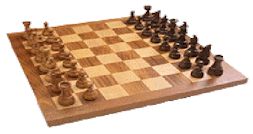 |
You know where all the friendly units
are
You know where all the enemy units
are
You know their precise strength and
capabilities
You see all the terrain
|
So... Why
will Kasparov still kick your butt??
Intelligence is not discovered, or harvested by sensors. It
is produced by soldiers with special technical training. This special training
is in Intelligence Analysis, and these soldiers are generally called Analysts.
This skill is not confined to a specific Military Occupational Specialty (MOS);
every Military Intelligence Soldier must do this! In Intelligence, there is
no place for the soldier whose sole contribution is the operation of a piece
of equipment. All must be able to think! They may use powerful automation
tools that amplify their cognitive abilities, but these tools in themselves
do not produce Intelligence. No matter how intelligent the computer or software,
it will always be incredibly more effective when wielded by the trained analyst.
In today's equipment-centric Army, this point is often lost.
Just as Intelligence Analysis encompasses more than just the
function of analysis, the production of Intelligence entails more than the
simplicity of the Intelligence Cycle. "Direct - Collect - Process - Disseminate"
summarizes the cognitive elements, but there is more!
When an organization receives a new mission, the commander and
staff must determine what they collectively know - and don't know.
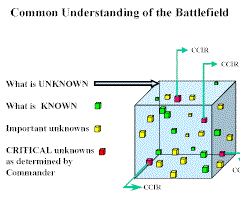 |
The large box represents
all that can be - but is not - known about the situation... |
The large box represents all that can be - but is not - known
about the situation. Some of the smaller boxes represent what is known.
Others represent a small number of the unknowns across all the Battlefield
Operating Systems that the staff has determined to be important. These are
called Information Requirements. Finally, there are a few Information Requirements
that the Commander determines are critical to mission success. These are
called Commander's Critical Information Requirements (CCIR). This process
of commander and staff mind meld for the purpose of identifying critical
information requirements is called the Common Understanding of the Battlefield.
It precedes mission analysis, and focuses the preparation of Staff Estimates.
Intelligence Soldiers start with the Intelligence-specific
CCIR and determine which things about the enemy and the environment are
the most important to mission success. Then they determine the scope and
parameters of these unknowns, and how they will affect enemy and friendly
forces.
Combining what they know about the enemy's capabilities and
intentions, they develop a set of theories that predict what the enemy might
do, by intent or accident, to thwart the friendly plan. They also postulate
where and when they might look in order to confirm or deny their theories.
This process emulates the enemy's mission planning and decision
making process, and is called Intelligence Preparation of the Battlefield
(IPB).
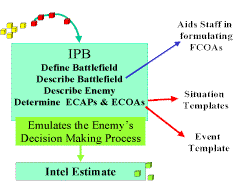 |
The process that emulates the enemy's
mission planning and decision making process is called IPB...
|
It is important to remember that these predictions, or Enemy
Courses of Action, are NOT a commitment on what the enemy will do prior
to the development of the friendly plan! Rather, they are a synthesis of
what he CAN do, what he WANTS to do, and what he MIGHT end up doing. The
set of Enemy Courses of Action are not an answer, but are like an algebraic
equation that clearly states what's known, unknown, and the parameters of
the unknowns. These Unknowns are called Intelligence Requirements. It is
important to remember that prediction involves expressing and explaining
uncertainty, not guesswork! Some tools for expressing uncertainty are statistics,
Enemy Decision Points, and cause-effect relationships.
The Military Decision Making Process (MDMP) is used by the
Staff to produce a battle plan that supports and is consistent with the
plan received from higher headquarters.
 |
The Staff uses the MDMP
to produce a battle plan... |
Friendly Courses of Action are formulated within the context
of the predictions of future enemy activity. Within the friendly plan, key
elements of uncertainty are identified as being critical to the success
of the mission. When they concern the enemy 's status, these questions are
called Priority Intelligence Requirements (PIR).
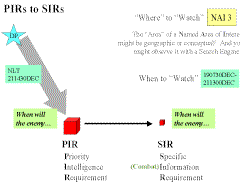 |
Questions concerning key aspects
of the Enemy Status are called PIR... |
The next step is to create a plan that will answer the PIR
in time to facilitate the friendly mission.
Some PIR are simple enough to be answered directly. By combining
this PIR with an enemy-situation-based time and location, the analyst creates
a Specific Information Requirements (SIR).
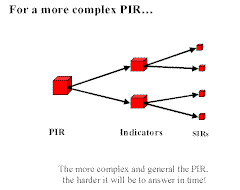 |
A complex PIR might
require several SIRs... |
A complex PIR might require several SIRs. An even more complex
PIR might require the formulation of intermediate Indicators that are themselves
broken down further into SIR. The more branches that exist between the PIR and
the SIR, the more difficult the PIR will be to answer.
The staff must assign their limited assets to collecting the data:
analytical assets are applied to gather data from within known databases, reconnaissance,
surveillance, and other collection assets are applied gather to data that is
not within known databases.
Combining an SIR with a Collector produces a Specific Order or
Request (SOR). You can Order those within your unit. You must Request from those
outside your unit. This process is called Collection Management.
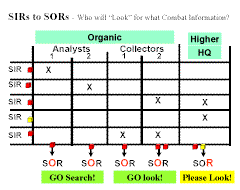 |
Combining an SIR with a Collector produces
an SOR... |
At Brigade and Battalion there exists a phenomenon known as "Reconnaissance
And Surveillance Planning". At these echelons, the Collection Plan frequently
tasks subordinate combat units to perform combat missions in order to gather
combat information, and you do not want this planning to happen in isolation
from the rest of the plan. Too much is at stake! However, too often this planning
is either done by the S2, or by a special "R&S Planning Cell"
that produces a special "R&S Plan". Too often this "R&S
Plan" is an afterthought to the main plan, and is poorly resources, synchronized,
and executed.
An emerging doctrine eliminates the current R&S planning process.
As PIR are identified during the Wargame, the S2 determines how best to answer
them. These SIR are immediately injected into the Wargame, converted to tasks
to subordinate units, and emerge in Warning Orders and the basic Operations
Order along with the other tasks.
Combat information is collected from sensors sampling the physical
environment, from analysts sampling the cyber environment, and from human sources
(enemy, friendly, neutral, allied, and other).
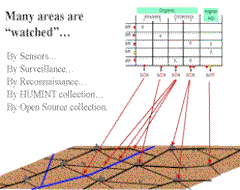 |
Many areas are watched... |
As combat information streams in, Intelligence Soldiers assess
its reliability, analyze it for meaning, try to fit it into everything else
they know, and attempt to synthesize a small piece of understanding within the
void of an assigned Unknown. Continued analysis, and perhaps redirected collection,
causes this small piece of understanding to grow, eventually filling the void.
Collaboration between analysts accelerates the growth, pieces of the puzzle
are assembled, and a unified picture starts to emerge
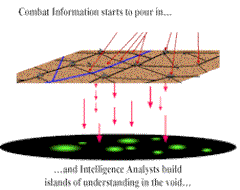 |
As combat information starts to pour
in, Intelligence Analysts build islands of understanding in the void... |
Continuous assessments determine whether or not all or part of a PIR has been
answered, and to what degree of certainty.
This process is called Intelligence Analysis, and it directly results in the
production of Intelligence.
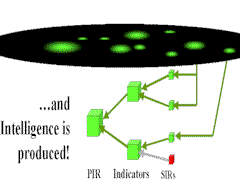 |
And Intelligence is
produced...
|
The Intelligence is delivered to those responsible for creating the plan and
executing the operation to defeat the enemy.
It may be used to trigger an anticipated decision, initiate the
destruction of essential enemy assets, influence the creation or change of a
friendly plan, or provide the essential ingredient for intuitive decision making.
This is how intelligence is Consumed.
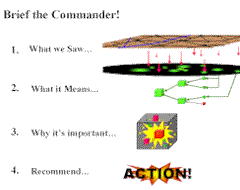 |
Intelligence is delivered to those responsible
for creating the plan and executing the operation... |
It is important to remember that the rate of production must equal
or exceed the rate of consumption! Part of the evaluation of a Friendly Course
Of Action must be an estimation of how well we can support the anticipated decisions
with the intelligence required to make them.
You are now certifiably equipped to be The Life Of The Party!
For those entertaining activities where you can use MS PowerPoint, like that
next Professional Development Seminar, you can get the digits here! >>
Powerpoint Version (960kB)
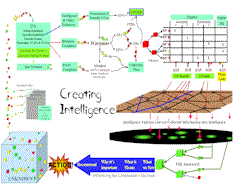
The entire Intelligence Creation Loop.
Click on image to Expand! (240k) |
© Copyright The S2 Company, 2002, All Rights
Reserved. Unlimited personal use and free distribution allowed.











